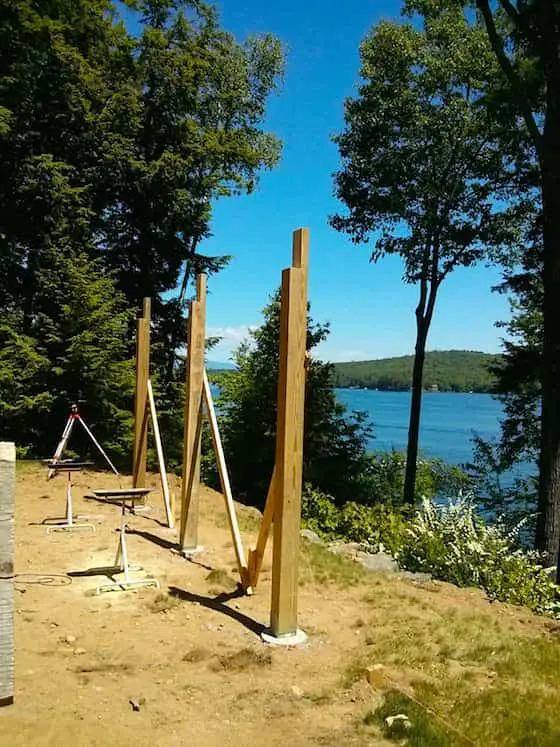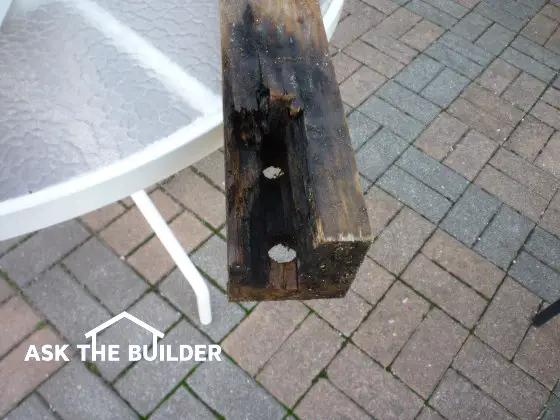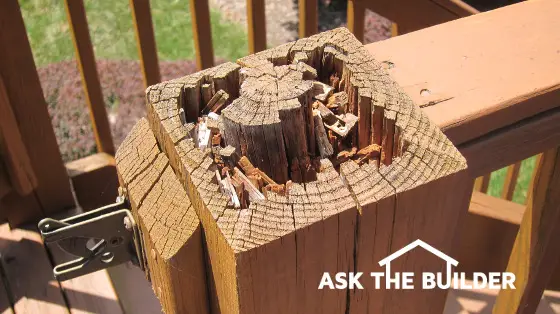Deck Construction Guide

These 6x6 treated lumber posts need a few more braces before the long double 2x12 beam is set in the L-shaped notches. The optical builders level on the tripod was used to ensure the seat of each notch is at the same elevation. Copyright 2025 Tim Carter
Deck Construction Guide - Life and Money-Saving Tips
Flowers and vegetables pop up out of the ground in the spring. So, too, deck support posts. You may be a homeowner that desires to create a wonderful outdoor room, or expand that small deck cobbled together by the builder of your home. Allow me to share with you deck construction tips that can save you time, and prevent expensive leaks into your home.
I’ve built more than my fair share of decks in the past forty years. I’ve also inspected many that I’d never set foot on because of the many defects. You can locate videos and articles about deck collapses on the Internet. A friend of my daughter was standing on a deck that collapsed. She broke her neck and ruptured her spleen. She’s lucky to be alive. You don’t want this to happen to you, your loved ones, or visiting guests. A deck construction guide like this can help prevent death or serious injury.
CLICK HERE to get my Deck Construction CHECKLIST!
More Deck Building Tips are Here
Tall Decks Can Sway
Decks that are higher than three feet off the ground can experience significant structural stresses from people dancing during a party. A deck can begin to sway back and forth if it lacks sufficient bracing to prevent the movement. Think about any wobbly table you might have set things on at a picnic or other outdoor gathering. A deck is really nothing more than a giant table with legs.
Decks can detach from houses without warning. There are many causes not the least of which are corroded bolts, wood rot from leaks at the connection point, and inferior construction methods employed by a homeowner with great intentions but little carpentry experience.
The most recent incident of this happened in Pittsburgh, PA. A porch roof on the rear of an older home collapsed. A porch is built just like a deck that's attached to a house. No students died in the mishap, but several received serious injuries that might plague them the rest of their lives.
Decks are HEAVY
The first thing you should know about is concentrated loads. The average deck weighs many hundreds of pounds. Some decks weigh tons once you install the decking, furniture, and possibly a hot tub.
Some of this weight will be transferred to your house should you bolt the deck to the house using a ledger board. Think of how approximately half of this weight is bearing on a handful of 1/2-inch bolts! The remainder of the weight might be concentrated on two posts that rest on a concrete pier.
The nails or bolts used to connect the porch roof, which is built just like a deck, couldn't support the weight of the students. The bolts or nails could have sheared off or they could have pulled out of the brick.
The concrete piers must be on solid soil and below the frost line should your deck be located where the ground freezes in the winter. The diameter of the concrete pier should be at least 16 inches. Architects I worked for years ago always specified a two-foot-diameter footing pad in the ground. The concrete pier would connect to this footing and stop about 6 inches above the grade.
It’s not a great idea to bury treated posts in the ground. They can rot or be attacked by insects even though the manufacturer states they’re safe for direct burial. The following two photos show how treated lumber can rot even if it's not buried.


This is a treated lumber post that's been well cared for. I know the homeowner. It's been regularly sealed yet it still rotted out! Copyright 2025 Tim Carter
Simpson Strong-Tie is a USA company that specializes in any number of high-quality connectors made to build decks. The special galvanized post bases, post-to-beam connectors, joist hangers, tie-down anchors, etc. they manufacture will enable you to build a strong deck that lasts. I’d visit their website and immerse yourself in all of their training aids and videos.
Be aware that the fasteners used to connect everything together must be able to withstand the corrosive brew created when rain falls on your deck. The rain leaches copper from the treated lumber. This liquid reacts with exposed bare steel causing it to corrode in short order. You must use fasteners that have a thick coating of zinc to protect the steel from the corrosive brew.
I feel the best decks are ones that are similar to a real table you have inside your home. The average table has four legs and is very stable. Imagine creating a deck that sits just two inches from the face of your home. There are no holes drilled into your siding or brick. Leaks into your home are eliminated.
Don’t discount the use of steel tubing in place of treated lumber posts. The first big deck I built over forty years ago employed 4-inch-square steel tubes. A local welder added a 10-inch-square plate at the base. It had a drainage hole in the center and four 9/16-inch diameter holes at the four corners. I used anchor bolts to connect the post to the concrete pier.
The top of the steel post had two plates welded to it creating a U-shaped notch that surrounded the horizontal wood deck beam. The steel posts were primed and finished painted before we built the deck. I visited this deck not too long ago and the steel looked as good as the day I installed it.
Column 1604